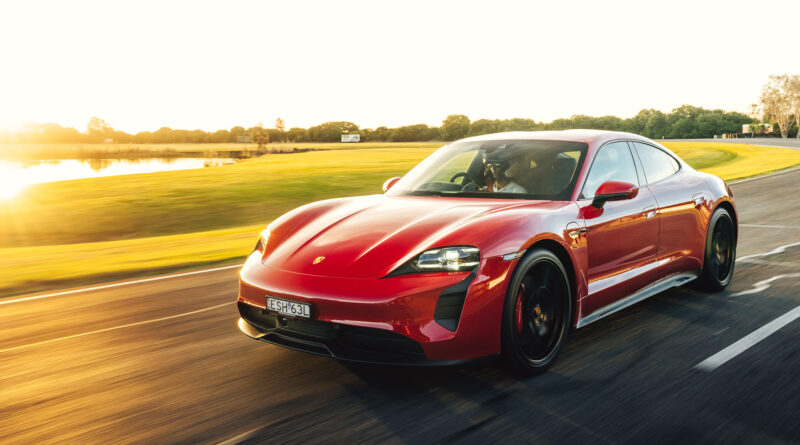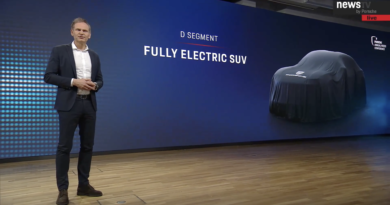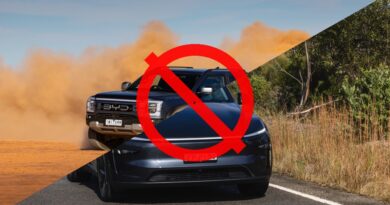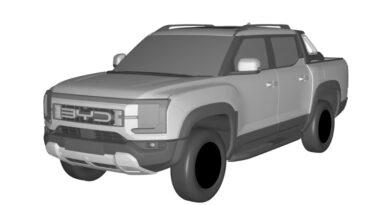Porsche Taycan GTS review
Pity the Porsche Taycan buyer, if you can. Not only is the waiting list so long they’ll struggle to get in one before 2023, but the range is so exhaustive it’s terribly hard to decide which one to pick.
Porsche will tell you this new Taycan GTS is an antidote for any procrastinators. It’s the sweet spot you’ve been waiting for. Extra sportiness with everyday drivability, Gran Turismo Sport-specific body and interior bits, the greatest range and efficiency of any Taycan, and the one most suited to track work. That’s important for Porsche owners with an image to maintain, no matter if it actually ever sees a race circuit.
The GTS is priced neatly between the Taycan 4S and Turbo models – $241,900 before on roads. A fair leap over the entry-level Taycan RWD ($159,700) and 4S AWD ($198,800), but decent change under the Turbo ($281,900) and even more bonkers Turbo S ($352,600).
The full Taycan range now stretches to eight, the quasi-wagon/SUV Cross Turismo in its 4, 4S and Turbo also available. Alas, unlike other markets, we’re not receiving a GTS version of it.
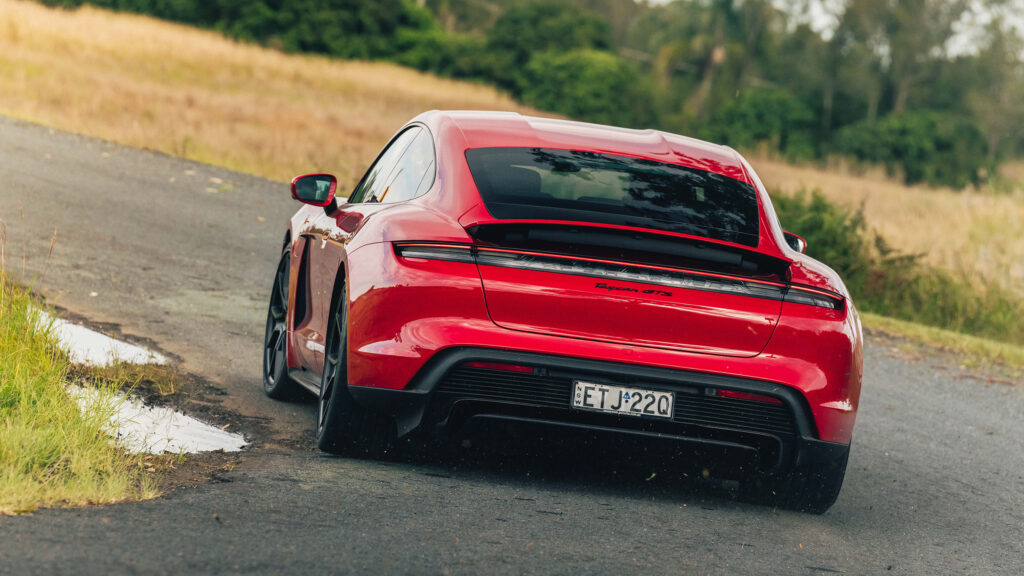
Value
With a drive-away of over a quarter-of-a-mill, buyers should expect plenty. Not least as the $80,000-cheaper Taycan RWD brings ample style, range, driver enjoyment and engineering genius for most buying Porsche’s EV debutant.
As standard, the GTS brings Porsche’s top-level 93.4kWh Performance Battery Plus. It means a range of 485km – 65km over the Turbo with the same power pack, and around 120km over the RWD and 4S with their 79.2kWh batteries.
You get more power for your dollars. The GTS unleashes 440kW with overboost using launch control, or 380kW in normal use. Torque’s a Turbo-matching 850Nm – a hefty jump over a standard Taycan RWD’s 240kW/345Nm, but well below the frankly ridiculous 1050Nm on tap in a Turbo S.
Speaking of the Turbo variants, the GTS borrows its electric motors – one on each axle – but bespoke adapted for the new model. Adaptive air suspension and Porsche’s electronic shock absorber system (PASM) have been specifically tailored with handling and dynamics to the fore.
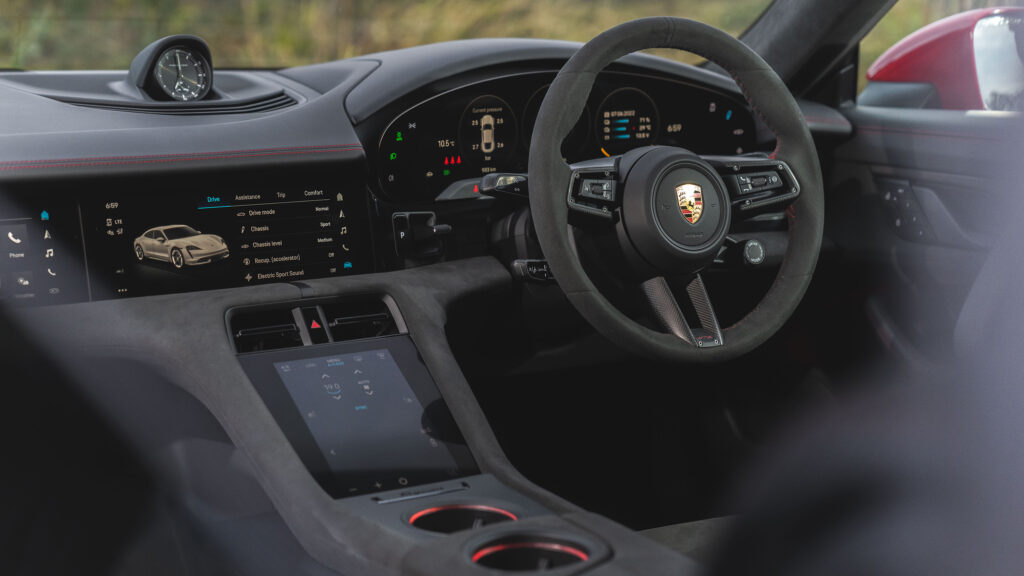
Porsche has included bits those keen on a sportier, rawer experience will see value in. There’s a GTS-exclusive SportDesign high gloss black rear diffuser, black side skirts and front bumper, while a black Porsche logo is integrated into the rear light strip. Tinted LED matrix headlights and matt black Taycan rear badge join the party, all goodies even $352,600 Turbo S buyers must fork out extra to snare.
Lightweight 20-inch stain black alloys are taken from the Turbo S, while 390mm front brake discs (up from 360mm) show track intent.
The Taycan’s Electric Sport Sound is also included, although adapted as a rortier GTS-specific note. It sounds a bit sci-fi but benefits the senses when you’re seriously pedalling along. It can be turned off if you prefer the sounds of silence.
Also on the inclusions menu is the Sport Chrono Package – normally a $2360 option to all but Turbo S buyers. It brings selectable drive modes on a rotary dial perfectly placed on a GT multifunction steering wheel.
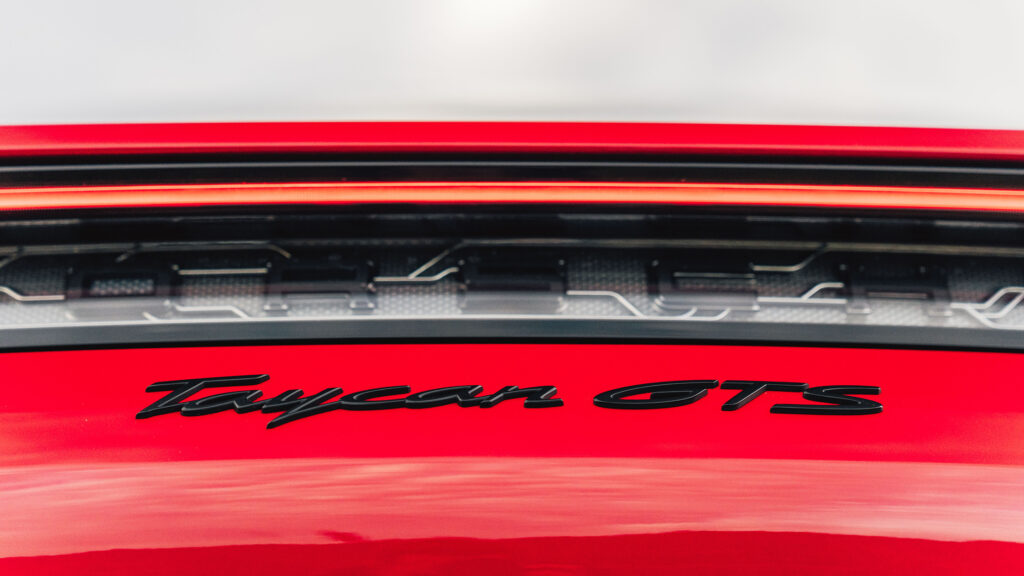
What’s missing? Our test GTS had a challenging $48,000 of cost options. Most were (arguably) unnecessary, but you’ll need an extra $1000 to get three rear seats (standard is just the two), ambient lighting’s $890 and a puddle light $600.
You don’t get the rear steering standard on a Turbo S (it’s $4300), or the Porsche Dynamic Chassis Control Sport (PDCC Sport) on Turbo and Turbo S – it’s another $6870.
Inside
Whatever Taycan you choose the interior’s a beautifully crafted technology-rich effort with a lovely driving position.
The GTS favours a racier flavour than the others – less leather, more Alcantara-like Race-Tex trim. It coats the seats, steering wheel, door panels, roof lining, lower dashboard and centre console. It feels gorgeous, especially as your hands grip the main touch-point steering wheel.
Included are a customisable 16.8-inch curved driver display, 10.9-inch central infotainment screen and a vertical screen below for climate and battery info. The GTS gives Bose surround sound, four USB-C ports and head-up display. Wireless Android Auto has arrived for this model year Taycan to join wireless Apple CarPlay, but there’s still no wireless phone charging to make it really useful.
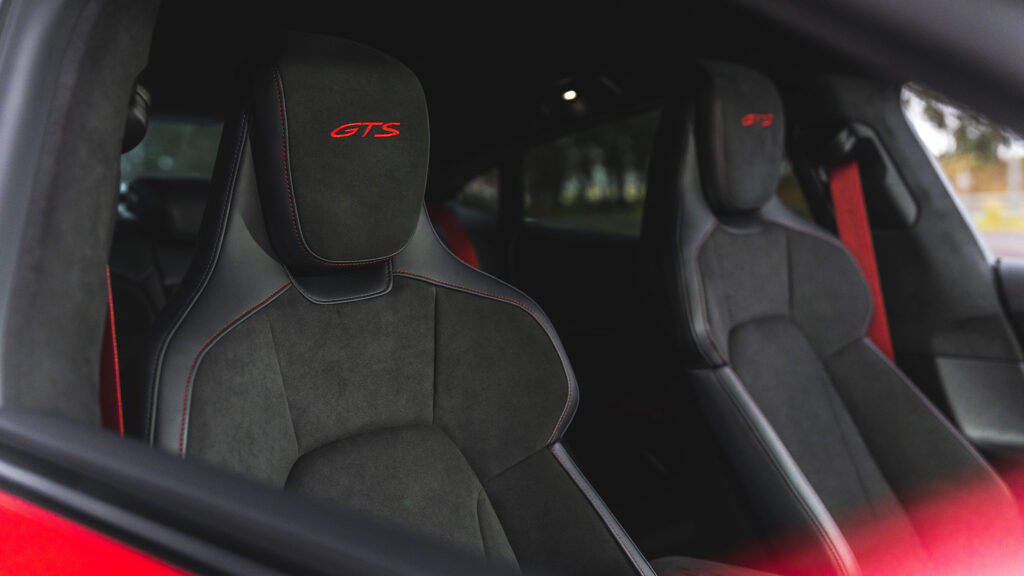
Seats are adjustable 18 different ways to secure your preferred driving position, and as you’d expect from a sporting Porsche, you can sink your bum nice and low in the cabin. Heated and ventilated seats up front are included.
The car come standard with two rear seats. These are adult-suitable as you sit very low in bucket-type chairs, offering good headroom and acceptable leg room. The optional third rear seat is emergency/child only.
It’s easy to spend big on options. Our tester had a Carmine Red GTS interior package ($8370) with red stitching throughout, GTS logo on the headrests, red seat belts and carbon for the steering wheel and cabin trim. Not cheap, but it ups the racy ambience.
A frunk holds a few shopping bags while the boot’s a not huge 366 litres – you’ll need to pack lightly for your grand tour. The roomier Taycan Cross Turismo with its 405 litre boot isn’t coming in GTS guise to Australia, though it exists in other markets.
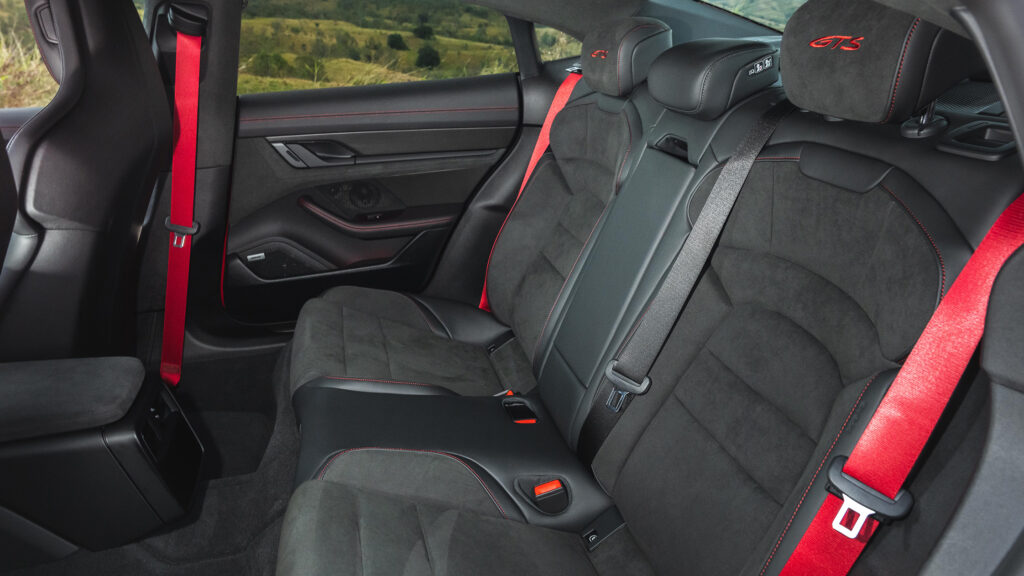
Performance and efficiency
While the flagship Taycan S finds 100km/h in an internal-organ mashing 2.8 seconds, the GTS does the same in a more sensible 3.7 seconds. Really, honestly, it’s all you need. Top speed is 250km/h.
The extra oomph over a 4S is welcome, but don’t expect the GTS to have shed any kilos despite its sportier remit. Weight matches the Turbo S variant’s 2295kg, making it 155kg over a 4S and 245kg more than a Taycan RWD, both featuring smaller battery packs.
The GTS’s Performance Battery Plus gives a range of 485km – the most of any Taycan. It’s an impressive leap over the 369km of the Taycan RWD and 365km the 4S (these jump to 434km and 414km with $12,000-optional Performance Battery Plus), and the Turbo’s 420km and Turbo S’s 405km.

Charging
The extra range is courtesy of the GTS being the most efficient: 25.9kWh/100km the official figure. Our road test, short though it was, saw a better return at 22.3kWh/100km, although it soon blew out on our track test.
With our comical current petrol prices, a decent Taycan inclusion is a three-year Chargefox subscription. This gives free access to any charger on its network – including the Taycan-preferring 350kW ultra rapid chargers – when you swipe your card at public charging stations.
The energy recovery through lifting off and braking is very impressive. It’s barely noticeable, and certainly there’s no rapid deceleration as found in many EVs. However, it’s a shame in city driving it can’t be driven with just one pedal as is common with many electric rivals.
The GTS’s 800-volt electric charge system means at a 350kW public charger the battery can go from 5-80 percent in 22.5 minutes ‘under ideal conditions.’ The Taycan’s maximum charge capacity is 270kW, and we’ve seen up to 260kW at public chargers on previous tests.
Porsche says it takes 93 minutes to go from 5-80 percent using a 50kW DC public charger (the most common type), or nine hours from 0-100 percent using an 11kW AC charger – such as a home wallbox.
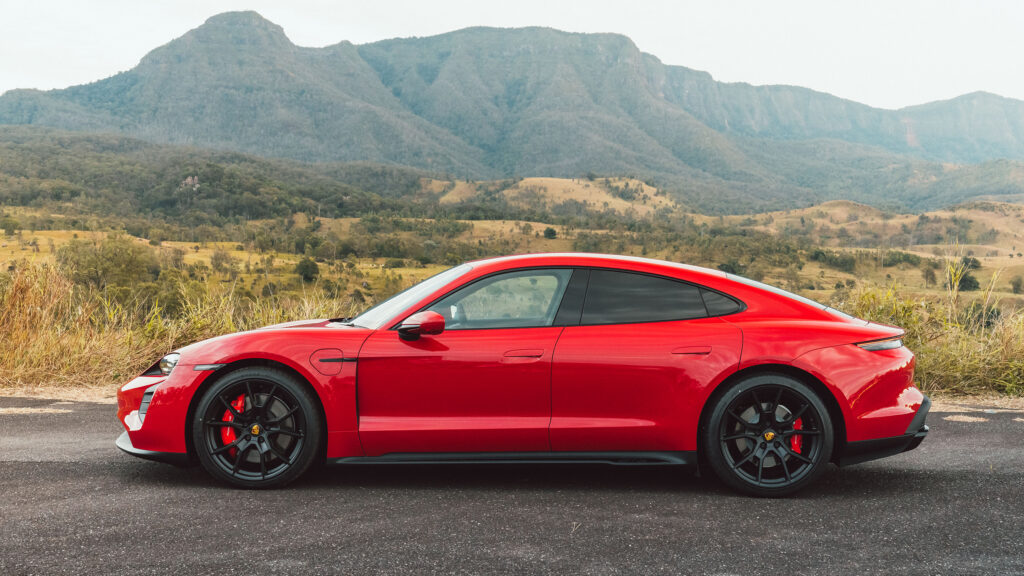
Ride and handling
Despite its weight the GTS mirrors other Taycans in being deeply impressive on the twisty stuff. It weighs 2.3-tonnes yet somehow tucks into tight corners and changes direction in physics-defying ways.
Big question is, is the GTS a truly sportier, more driver-orientated Taycan? One worth forking the extra dollars on? It’s tough to answer without testing one back to back with, say, a cheaper 4S – sadly something not offered on the GTS’ road and track launch test.
The GTS you buy probably won’t be as well optioned as our tester, muddying the waters further. Porsche Dynamic Chassis Control Sport (PDCC Sport) with active anti-roll bars ($6870), rear-wheel steering ($4300) and larger 21-inch wheels ($5520) were added, and of course will change the way a GTS handles corners.
It appears there’s no erosion of the Taycan’s comfortable everyday driving manners. In Normal mode its behaviour is quite serene, the three-chamber adaptive air suspension shuffling through spring rates in the blink of an eye to suit the surface. In town and highway it’s hard to fault as a whisper-quiet grand tourer. This despite the 21-inch skinny rubber option fitted to ours.
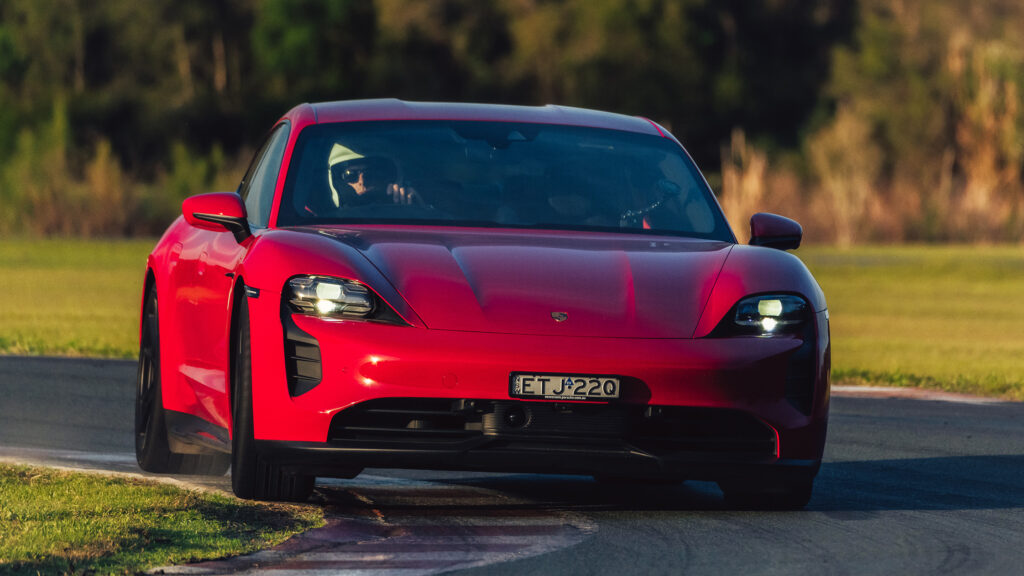
A flick of the steering wheel’s rotary dial offers up Sport and Sport Plus modes and all changes. The engine note sounds angrier – more mongrel – than other Taycans (though still quite sci-fi); steering and throttle sharpen and everything’s more focused on attack. Throttle response is incredible as you’re pinned in place – it feels eager, rapid and beautifully balanced.
This was my first opportunity to try a Taycan of any type on the track. Only here can you fully appreciate how these electric Porsches pull from standstill and seemingly never stop. It’s mind scrambling, not least as it all happens with very little noise.
You can’t attack track corners in the same way you would a lighter sportscar, such as Porsche’s 911. The Taycan GTS can’t work miracles with its weight – you feel it if you carry too much speed into corners and it’ll plough on somewhat when you do.
You soon find a way to work around this. Once you do the GTS shows a pleasingly playful side on track, perhaps in a way other Taycans don’t. Porsche has set the GTS’s brain up to bias more power and torque to the rear motor, so when coming out of corners it feels more akin to a rear-drive sportscar. If you prefer greater driver involvement with the rear end sliding a bit when really pushing, the GTS is your pick.
Despite a regular hammering, brakes felt responsive and durable despite not matching the Turbo and Turbo S’s even larger braking systems.
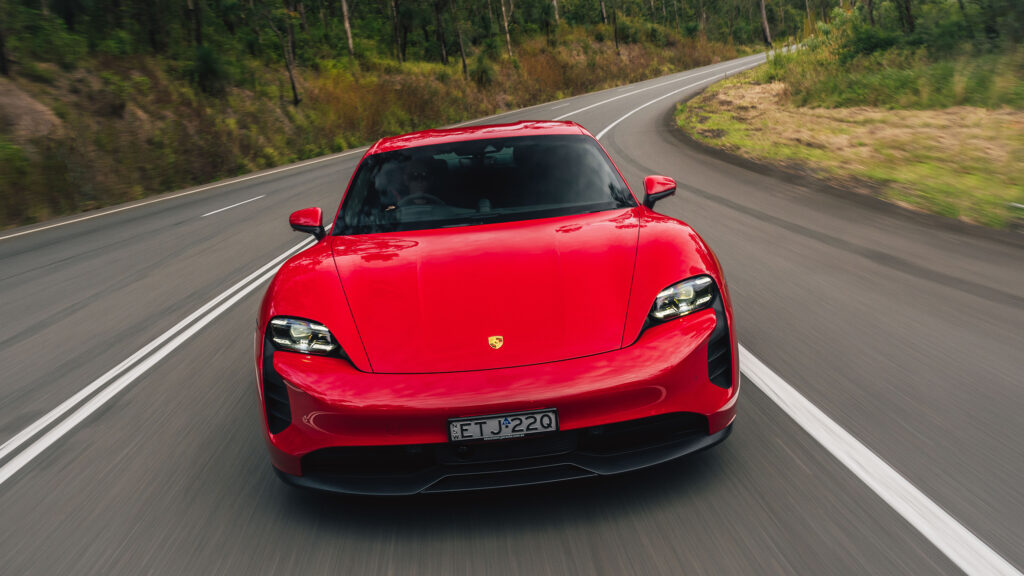
Party tricks
Launch control. This gives a beautifully controlled, rapid standing start to blow your mind. An overboost function ups power from 380kW to 440kW for a few seconds, making you look like you’ve nailed a zero-wheelspin F1 race start.
Safety
There’s a lengthy list of assist systems that are impressively non-invasive to the drive experience – they feature on every Taycan.
There’s radar cruise control as standard while Traffic Jam Assist steers, accelerates and brakes for you up to 60km/h.
Also included are Lane Change Assist, Lane Keeping Assist, auto emergency braking, front and rear parking sensors, cross road assist and ten airbags.
There’s a surround view camera showing two different angles as you park. It deliberately distorts the image, presumably to make parking more accurate, but takes some serious getting used to.
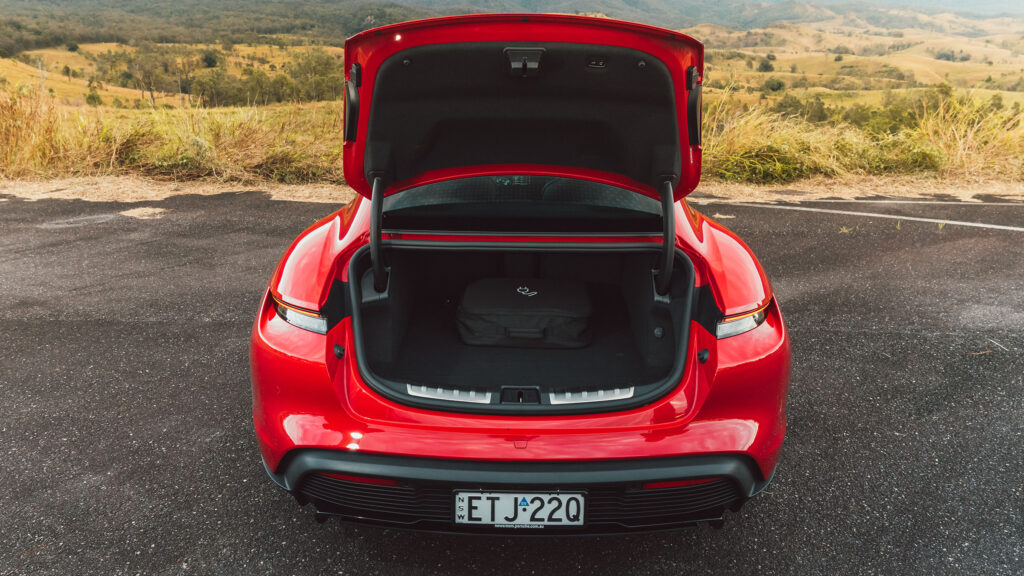
Verdict
With so many Taycans now on offer, it’s cliched but probably true to call this GTS the sweet spot, if not the best value pick.
Its high specification, larger battery for excellent range and sportier setup and styling lend themselves well to Porsche owners wanting to track their EV, or at least look like they will.
But we can’t escape the price – it’s over $250,000 on the road without any options picked – a serious leap over the already very impressive and more affordable 4S and RWD models.
We’d have to test a GTS without the cost option chassis bits – and against a 4S specifically – to see how much sportier it is, but at first try it feels dynamic, eager and at times playful, without losing the comfort required of a grand tourer.
Another superb Taycan, and buyers with deep pockets now have even greater choice on the Porsche EV menu.
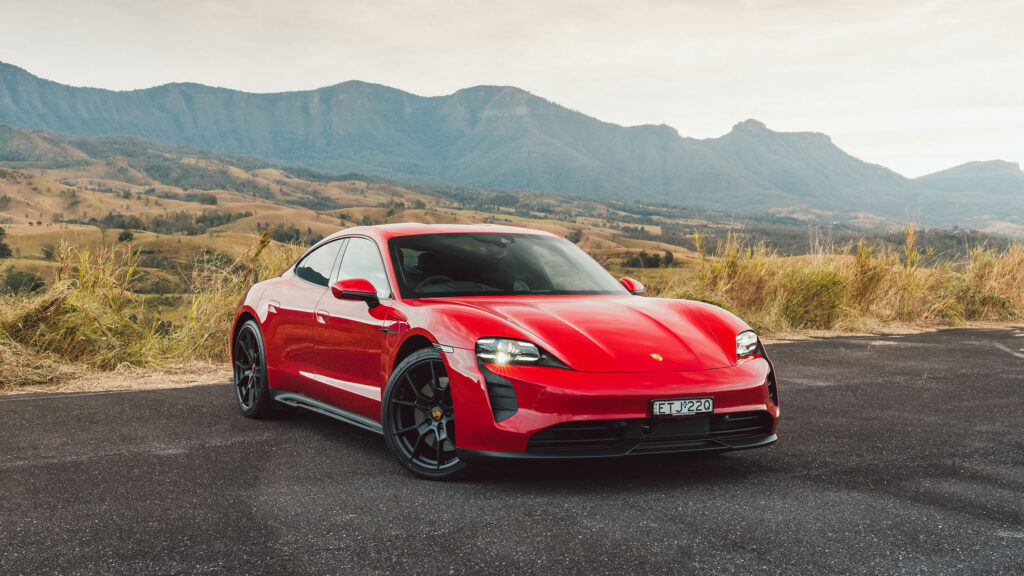
Porsche Taycan GTS specifications
Price: $241,900 plus on-road costs ($289,170 plus o.r.c as tested)
Basics: EV, 4 or 5 seats, 5 door sedan, AWD
Range: 485km (WLTP)
Battery capacity: 93.4kWh
Warranty: 3 years, unlimited km
Battery warranty: 8 years/160,000km
Energy consumption: 25.9kWh/100km (22.3kWh/100km as tested)
Motors: 2 (front and larger rear) 380kW/850Nm (440kW with overboost)
Transmission: 2-speed (rear), single speed (front)
AC charging: 11kW, Type 2 plug
DC charging: 270kW, CCS combo plug
0-100km/h: 3.7 seconds

